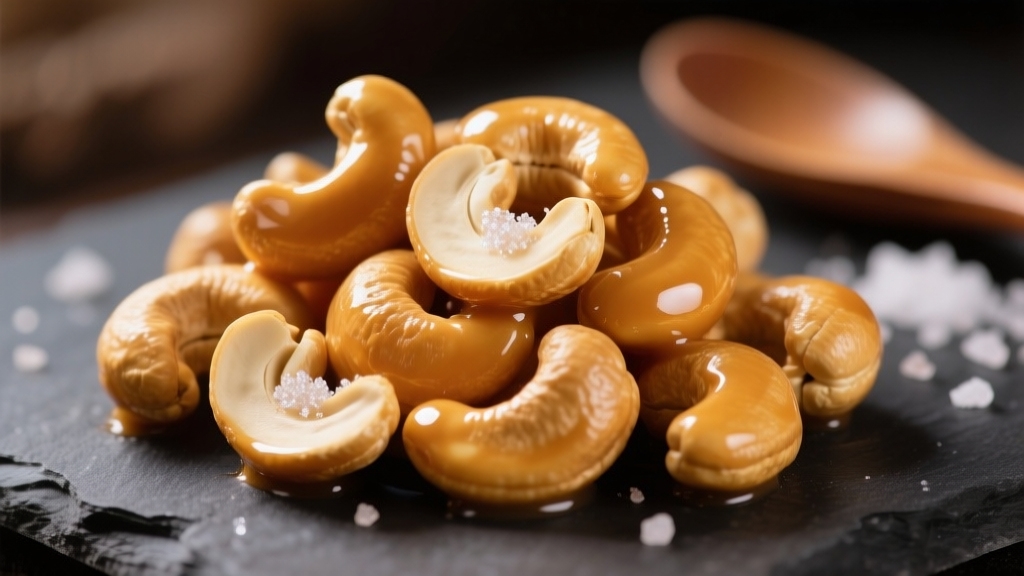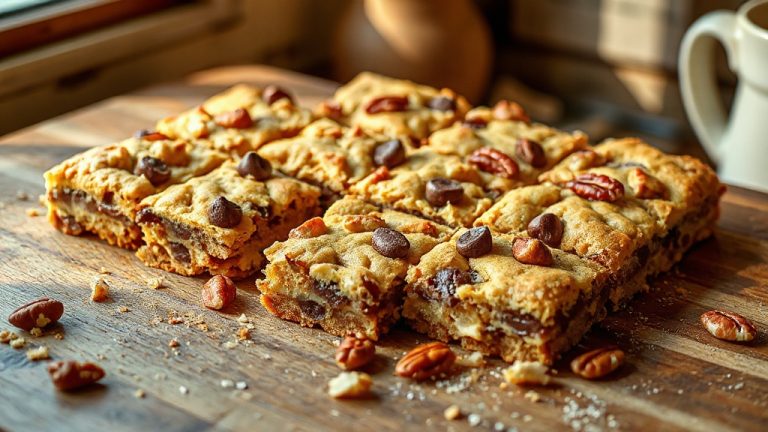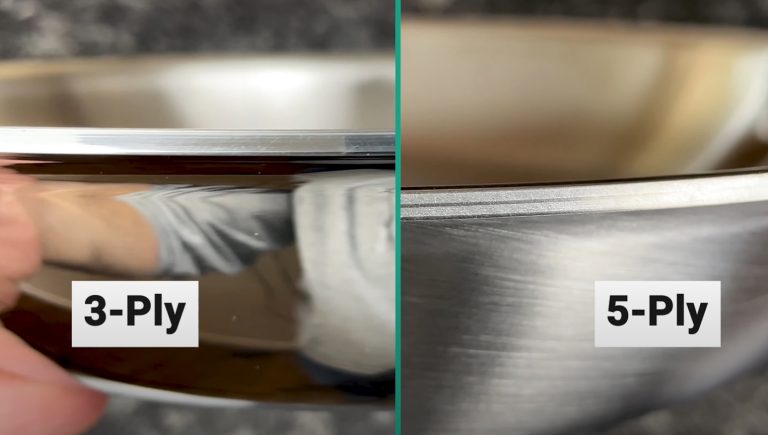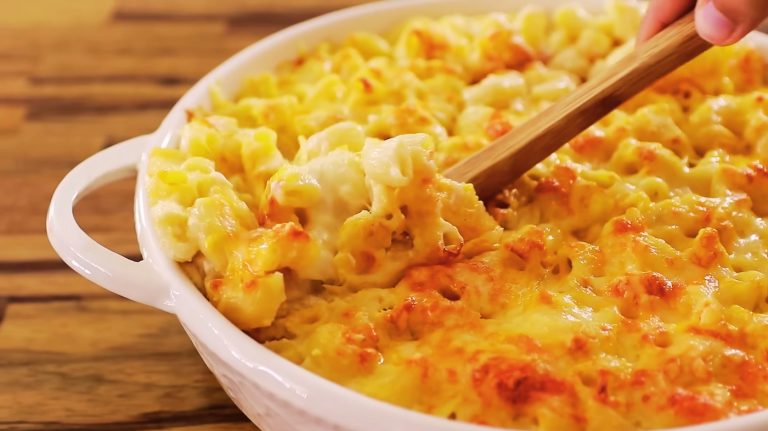Candied Cashew Nuts Recipe: Easy Sweet Crunchy Treats
You’ll start by roasting whole, raw cashews until crisp. Then simmer sugar and water into a glossy syrup, adding warm spices like cinnamon or cardamom for depth.
Coat the nuts evenly in the syrup, then bake at a low temperature to caramelize. Cool them on parchment to retain crunch.
Finish with a sprinkle of sea salt or zest for extra flair. Keep these tips in mind, and you’ll master perfectly crunchy, irresistibly sweet candied cashews in no time.
Key Takeaways
- Roast whole, raw cashews evenly until crisp but not burnt for optimal flavor and texture before coating with syrup.
- Prepare a clear, glossy sugar syrup by dissolving sugar and water in a 2:1 ratio over low heat without boiling.
- Coat cooled roasted cashews thoroughly with syrup, stirring gently for about 10 minutes to ensure even coverage and prevent clumping.
- Bake coated cashews at 250°F to 325°F for 20-30 minutes, stirring every 10 minutes to caramelize evenly without burning.
- Cool candied nuts completely on parchment before storing in airtight containers to maintain crunch and prevent moisture buildup.
Quick Recipe Reference of Candied Cashew Nuts
| Ingredients / Tools | Steps / Actions |
|---|---|
| 2 cups raw cashews | Roast evenly at 325°F for 10–15 minutes until golden brown and fragrant. |
| 1 cup granulated sugar | Combine with ½ cup water in a saucepan; stir gently over low heat until sugar dissolves. |
| ½ cup water | Maintain low heat to prevent crystallization and form a glossy syrup. |
| 1 tbsp unsalted butter | Add to syrup for a smooth, rich coating texture. |
| ½ tsp cinnamon or cardamom | Mix in for warm spice flavor before adding cashews. |
| Pinch of salt | Balances sweetness and enhances nutty flavor. |
| 1 tsp vanilla extract (optional) | Add after removing from heat for aromatic depth. |
| Baking sheet & parchment paper | Line tray for non-stick cooling and easy cleanup. |
| Mixing spoon or spatula | Stir gently to coat all nuts evenly with syrup. |
| Oven preheated to 250°F–325°F | Bake coated cashews for 20–30 minutes, stirring every 10 minutes. |
| Cooling rack or silicone mat | Spread baked cashews in a single layer to cool completely. |
| Optional toppings: sea salt, powdered sugar, zest | Garnish for extra flavor and presentation. |
| Airtight jar or container | Store cooled cashews to maintain crunch and freshness. |
Ingredients Needed for Candied Cashew Nuts
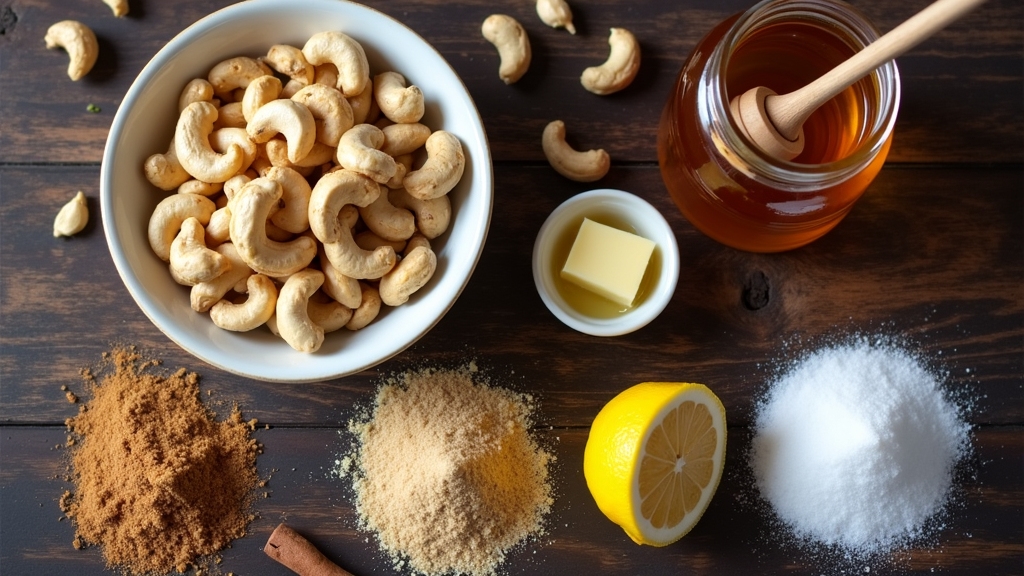
When you’re ready to make candied cashew nuts, gathering the right ingredients is key to achieving that perfect balance of sweetness, crunch, and flavor.
Start with whole cashews: raw, unsalted, or lightly roasted without additives. It is important to ensure even drying by rotating trays if you choose to dehydrate your nuts at home for the best texture and flavor even drying.
You’ll need white granulated sugar to create that crisp, sweet coating, although cane or brown sugar can work too.
Plain water dissolves the sugar into syrup, while unsalted butter adds rich creaminess. A pinch of salt can balance the sweetness if you like.
For extra flavor, consider cinnamon for warmth, vanilla extract for aroma, or a hint of cardamom or saffron for exotic notes.
Some recipes use egg whites to help coatings stick evenly, but vegan versions rely on butter and syrup.
Both roasted and unroasted cashews work well, with roasted cashews providing a stronger salty and sweet flavor and unroasted offering a sweeter, less salty taste cashew options.
Preparing Cashews for Candying
To kick things off, grab some raw cashews that are all about the same size and look good—no blemishes, please! This little detail is key for candying them perfectly.
Now, let’s talk roasting. Lightly roasting your cashews until they’re golden not only enhances their amazing aroma but also helps them soak up that sugary coating like a dream. It’s important to use roasted, salted nuts for optimal flavor balance when making candied cashews. Additionally, understanding the material durability of kitchen tools can help you maintain their quality during preparation.
Nail these first steps, and you’re well on your way to making some wonderfully crunchy candied cashews!
Selecting Quality Cashews
Although selecting quality cashews might seem straightforward, paying close attention to their physical attributes and moisture content can dramatically elevate your candied nut’s flavor and texture.
Choose whole, kidney-shaped cashews with a rich buttery flavor and a firm, crisp texture. Avoid nuts with cracks, splits, or signs of moisture excess. Aim for 5% moisture content in processed cashews to ensure shelf stability and proper candying.
Ensuring the cashews are free from additives and preservatives guarantees a pure and natural experience that enhances the final product. Proper lighting when preparing your kitchen can improve visibility and precision, with options such as energy-efficient LED lighting providing bright, consistent illumination.
| Attribute | Ideal Characteristics |
|---|---|
| Shape | Kidney-shaped, whole |
| Size | Uniform for even caramelizing |
| Moisture Content | ~5% for processed cashews |
| Color | Gray to brownish, no mold |
| Flavor & Texture | Buttery, firm, crisp |
Selecting organic and certified options also supports quality and sustainability.
Roasting Techniques Overview
Since roasting transforms raw cashews into the perfect base for candying, understanding different roasting methods is vital to achieve the ideal texture and flavor.
You can choose traditional drum roasting, which uses rotating heated drums at 180-200°C for 15-20 minutes, giving you good control but demanding constant attention.
Oil bath roasting immerses nuts in hot oil around 190-200°C, roasting them quickly in 2-3 minutes. This method is great for commercial scale but requires careful oil management.
Oven roasting at 325-350°F for 10-15 minutes with stirring offers even browning and precise temperature control.
Stove-top pan roasting lets you dry roast with constant stirring for 10-15 minutes to develop rich aroma.
Whichever method you pick, aim for uniform golden brown cashews, avoid broken pieces, and cool them thoroughly to ensure flawless candy coating adherence. Proper roasting temperature and time are essential to make the shells pliable and kernels intact, which improves kernel recovery.
Making the Sugar Syrup
When you combine sugar and liquid over gentle heat, you’ll create the glossy syrup that forms the sweet foundation for candied cashew nuts.
Use two parts sugar to one part liquid, either water or nut milk, to achieve the right syrup consistency. Stir continuously over low heat to dissolve the sugar fully without boiling, which prevents crystallization and guarantees a clear, shiny syrup. This 2:1 syrup ratio is recommended for a more intense flavor and perfect syrup texture.
Combine two parts sugar with one part liquid, stir gently without boiling to ensure a clear, glossy syrup.
Granulated sugar may take a bit longer than caster sugar to melt completely. After about 3-4 minutes, you’ll notice the syrup thickening as water evaporates, creating a sticky texture perfect for coating.
Once done, pour the warm syrup into sterilized containers for storage. This careful process assures your syrup is smooth, glossy, and ready to transform your roasted cashews into irresistible candied treats.
Adding Flavor Enhancements
Once your syrup has reached that perfect glossy sheen, you can start enhancing the flavor to make your candied cashew nuts truly stand out.
Try adding aromatic spices like cardamom for citrusy warmth, cinnamon for a sweet-spicy touch, or a pinch of cayenne to bring a subtle heat. Vanilla extract introduces delicate floral undertones, while a drizzle of maple syrup post-caramelization lends a rich, natural sweetness.
For a sophisticated twist, sprinkle saffron for its exotic aroma and golden hue. Saffron not only adds flavor but also provides a beautiful yellow color that enhances the visual appeal of the nuts, making them ideal for festive gifts.
Don’t forget to balance sweetness by incorporating a touch of seasoned salt or coconut flakes for added texture and nutty depth. Incorporating flavor enhancements at the right stage ensures the best absorption and intensity of taste.
These enhancements elevate your candied cashews from simple to sensational, creating a multi-layered flavor experience that’s both unique and irresistible.
Coating Cashews With Syrup
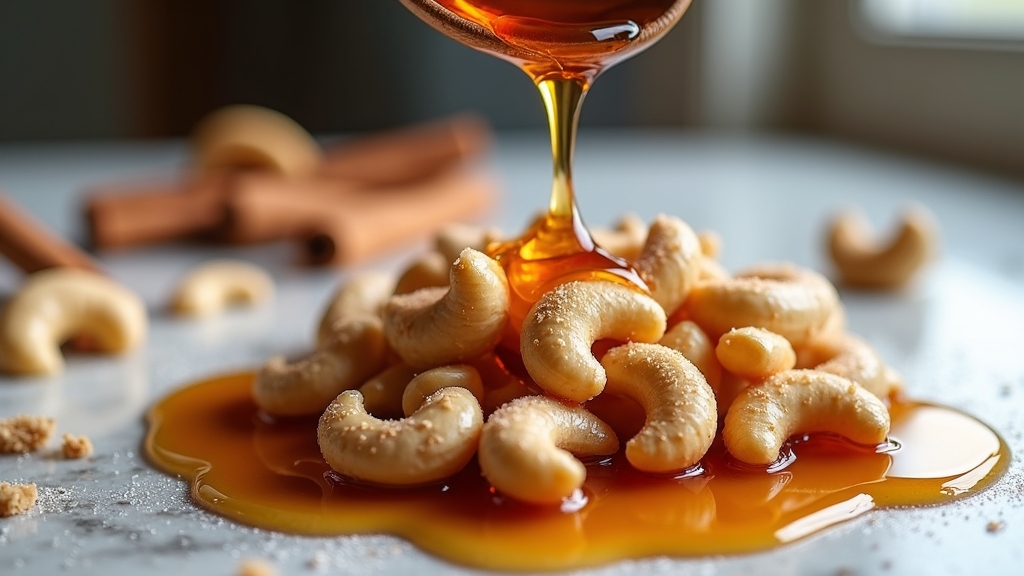
Although getting the syrup just right takes patience, coating your cashews with it is where the magic truly happens.
Mastering the syrup is key, but the real magic shines when coating each cashew perfectly.
You’ll want a syrup made from sugar, water, a pinch of salt, and a tiny bit of xanthan gum to keep things smooth and prevent clumps. This syrup acts similarly to the slurry base used in dry-roasted nut coatings, providing the adhesive layer necessary for flavor and texture. Using the right temperature control during heating is essential to achieve the ideal syrup consistency.
Heat and stir the syrup gently until it reaches the perfect sticky consistency, often called the “one string” stage.
Once cooled to the right temperature, add your roasted cashews and stir continuously for about 10 minutes, ensuring every nut is evenly coated.
Use a pan or coating machine to keep the syrup flowing smoothly without crystallizing.
Finally, spread the nuts out on a greased surface so the sugary layer can cool and harden without sticking, giving you that glossy, irresistible finish.
Baking and Caramelizing Process
As you slide the coated cashews into the preheated oven, maintaining the right temperature between 250°F and 325°F becomes essential to developing that perfect caramelized crunch without burning.
Keep your oven steady and bake for 20 to 30 minutes, stirring every 10 minutes to avoid clumping and ensure even caramelization. Using a heat diffuser can help maintain even heat distribution, preventing scorching during baking.
Cashews, which are native to northeastern Brazil, have been enjoyed globally after being spread by Portuguese explorers in the 16th century.
Watch closely as the sugar dissolves, turning from a sandy texture to a luscious golden caramel glaze.
The Maillard reaction between the nut proteins and sugar deepens flavor and browning, while the egg white coating crisps into a delicate shell.
As the nuts toast to a rich amber color, remove them just before they darken too much, preventing bitterness.
This careful process guarantees that irresistible balance of crunch and sweetness you’re aiming for.
Cooling and Garnishing Tips
After pulling your cashews from the oven, the way you cool them plays a big role in locking in that perfect crunch and glossy caramel finish.
Spread the nuts out in a single layer on parchment paper or a silicone mat to prevent sticking and clumping. Use a cooling rack to promote air circulation and speed setting, stirring gently every five minutes to keep them separated. This cooling process is important because nuts get crunchier as they cool, enhancing their texture.
Let them cool completely at room temperature—usually a couple of hours—for ideal texture.
Once cooled, elevate their appeal by lightly dusting with powdered sugar or cinnamon, sprinkling flaky sea salt, or adding finely chopped zest.
For a festive touch, drizzle melted chocolate or scatter crushed pistachios on top.
These simple garnishing tips enhance both flavor and visual allure without compromising crunch.
Storing Candied Cashew Nuts Properly
To keep your candied cashew nuts fresh and crunchy, it’s super important to store them in airtight containers.
You can keep them at room temperature for a while, but if you want them to last even longer, consider freezing them! Just a little tip: make sure to avoid moisture because it can lead to clumping and spoilage.
Using glass jars or quality freezer bags works really well for this.
Candied nuts should be completely cooled before storing to prevent moisture buildup inside the container.
Trust me, taking these extra steps will help you enjoy their sweet, crisp flavor for weeks and even months. Enjoy your delicious snacks!
Optimal Storage Conditions
When you want to keep your candied cashew nuts fresh and flavorful, choosing the right storage conditions makes all the difference. You’ll want to maintain a cool, dry, and consistent environment to protect their crunch and sweetness.
Avoid direct sunlight and humidity, which can turn them stale or soggy. Using airtight containers like glass jars preserves their aroma and texture without absorbing unwanted odors.
Refrigeration or freezing can extend freshness, but proper packaging is key to prevent moisture buildup.
Here are essential tips for ideal storage conditions:
- Store in airtight, non-porous containers like glass jars.
- Keep in a cool, dry place away from heat and moisture.
- Avoid plastic containers that absorb odors.
- Protect from direct sunlight and temperature fluctuations.
- Consider refrigeration after a week for extended freshness.
For the best longevity, using vacuum sealing can significantly extend the shelf life by minimizing air exposure.
Shelf Life Duration
Although candied cashew nuts are a delicious treat, their shelf life varies markedly depending on how you store them. At room temperature, keep them in an airtight container, and they’ll stay fresh for up to two weeks. Refrigeration extends freshness to about three months, while freezing can preserve them for up to six months without losing flavor or texture.
Storing them away from direct sunlight and moisture is crucial to prevent rancidity and maintain quality. Proper packaging is key to maintaining that perfect crunch and sweetness. It is important to monitor storage conditions carefully, as improper temperature or humidity can accelerate spoilage through overheating concerns.
| Storage Method | Duration |
|---|---|
| Room Temperature | Up to 2 weeks |
| Refrigerated | Up to 3 months |
| Frozen | Up to 6 months |
| Airtight Packing | Essential |
Moisture and Clumping Prevention
Since moisture is the main enemy of candied cashew nuts, you’ll want to make certain they cool completely before storing them. Warm nuts trap steam, causing condensation that softens the sugar coating and leads to clumping.
Spread them out on parchment to cool uncovered for at least 20 minutes, allowing excess moisture to evaporate. For extra crispness, letting the nuts sit uncovered overnight can enhance their brittle texture, making them even more enjoyable. Proper handling and storage techniques are key to maintaining their quality and preventing moisture damage.
Once cooled, store your nuts in airtight containers to keep crispness intact and prevent moisture intrusion.
Keep these tips in mind for moisture and clumping prevention:
- Use clean, dry airtight glass jars or sealed plastic bags.
- Store at room temperature, away from heat and humidity.
- Avoid frequent container openings to limit air exposure.
- Reheat softened nuts at 300°F for 5-10 minutes to restore crunch.
- Freeze fully cooled nuts in airtight bags for longer storage.
This approach preserves their brittle texture and delicious crunch. The recipe also allows for variations such as adding sea salt after cooking to customize the salted-sweet flavor to your liking.
Alternative Cooking Methods for Candied Cashews
Exploring alternative cooking methods for candied cashews lets you tailor texture, flavor, and preparation time to suit your preferences.
On the stovetop, you’ll cook cashews in a bubbling sugar syrup, stirring constantly to caramelize the sugar evenly. This method lets you add warming spices like cardamom or cinnamon right into the syrup. You can also incorporate smoked paprika and cayenne pepper into the coating to enhance the smoky and spicy notes.
If you prefer crunchier nuts, try oven baking them coated with honey and coconut oil at 300–350°F for 10–15 minutes, tossing occasionally for even caramelization.
For a quicker, healthier option, air fry cashews at 300°F for about 3 minutes before coating with syrup. Just watch closely to prevent burning.
You can also experiment with sugar-free sweeteners like maple syrup or allulose, adjusting temperatures carefully to achieve that perfect, glossy candy coating.
Frequently Asked Questions
Can I Use Salted Cashews Instead of Unsalted for Candying?
Yes, you can use salted cashews instead of unsalted for candying, but you’ll want to adjust your recipe.
Cut back on added salt and maybe tweak the sugar to balance the sharp salty-sweet contrast.
Keep an eye on how the salt affects caramelization and texture.
Stir carefully to prevent clumping, and consider flavor pairings like cinnamon or cayenne to complement the saltiness.
Testing small batches first helps you perfect the balance.
How Do I Fix Sugar Crystallization if the Syrup Becomes Grainy?
When your syrup turns grainy, it’s like a storm cloud on a sunny day. Don’t worry, you can fix it.
Gently reheat the syrup just enough to melt those sugar crystals without burning. Add a splash of water and a few drops of lemon juice or corn syrup to break up the crystallization.
Stir carefully or avoid stirring at first, then cool properly. This resets the syrup’s smooth shine and keeps your candy perfect.
What Is the Best Way to Recycle Leftover Sugar Syrup?
The best way to recycle leftover sugar syrup is to concentrate it through vacuum evaporation around 70°C to avoid caramelization.
Then use techniques like crystallization or membrane filtration to recover sugars.
You can also apply saccharification enzymes or microbial fermentation to convert leftover syrup into valuable biochemicals.
Treating the syrup with activated charcoal and decolorization improves quality, making it reusable in your processes while reducing waste and boosting sustainability.
Are Candied Cashews Suitable for People With Nut Allergies?
You shouldn’t offer candied cashews to anyone with nut allergies since tree nut allergies affect up to 7.3% of people in some regions.
Even tiny amounts can trigger severe reactions, including anaphylaxis. Because cashews are tree nuts, they contain proteins that allergic immune systems mistake as threats.
It’s safest to avoid them entirely and opt for hypoallergenic alternatives, which are still in development but hold promise for the future.
Can I Substitute Honey for Sugar in the Candying Process?
Yes, you can substitute honey for sugar, but expect a softer, chewier coating since honey resists crystallization and holds moisture.
You’ll need less honey because it’s sweeter, and you might have to adjust cooking time and temperature to avoid burning.
Honey adds a floral flavor, changing the taste profile, and may reduce shelf life due to its hygroscopic nature.
Experiment with combining both for a balanced texture and flavor.
Bring Sweet Perfection to Your Snack Table
Now that you’ve mastered candied cashew nuts, you’re ready to sweeten any snack time or party spread with ease. Just remember, practice makes perfect. Don’t be discouraged if your first batch isn’t picture-perfect.
With each try, you’ll get closer to that golden, crunchy dream. Store them right, and they’ll stay fresh as a daisy, ready to delight your taste buds whenever the craving hits.

